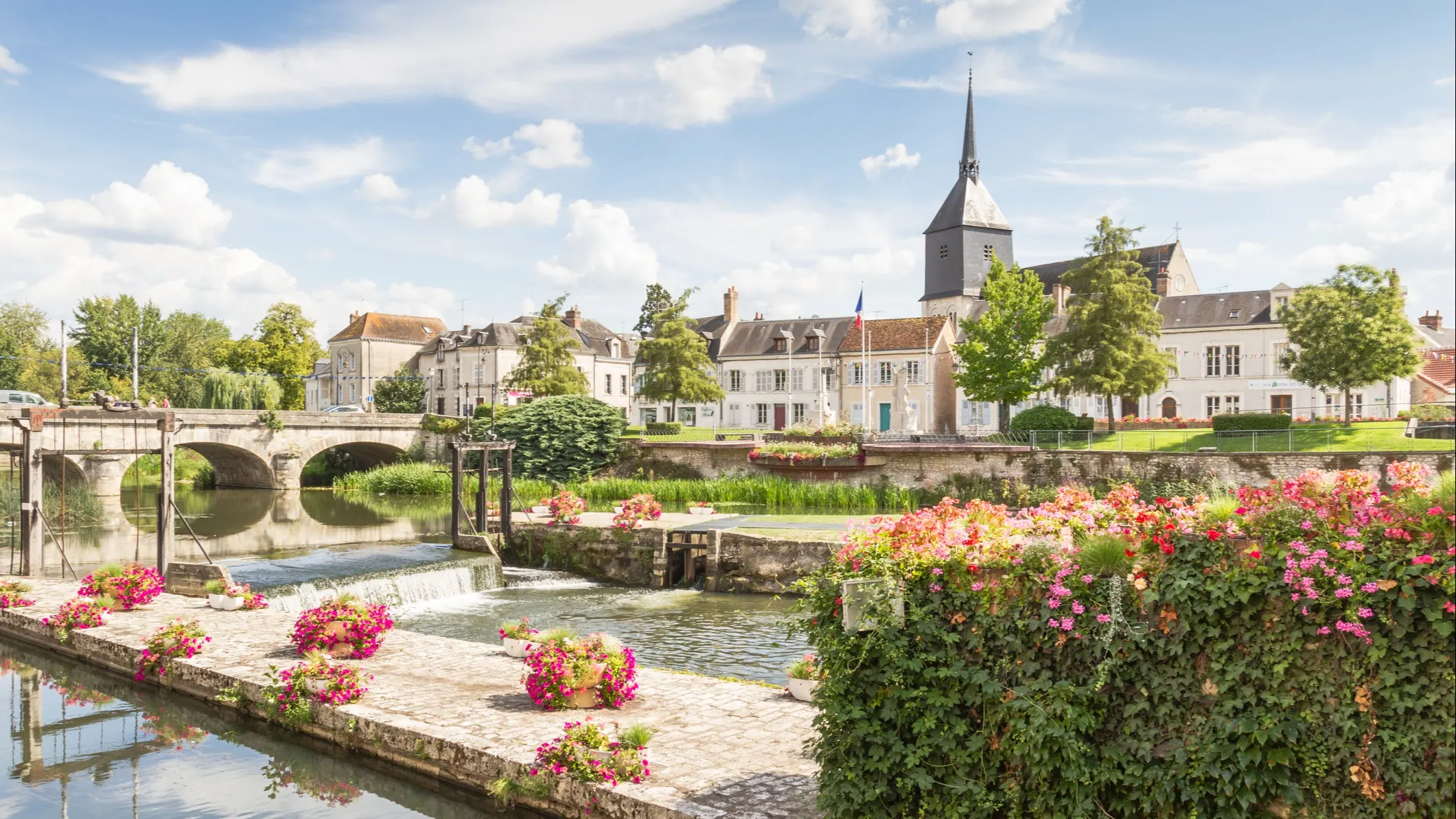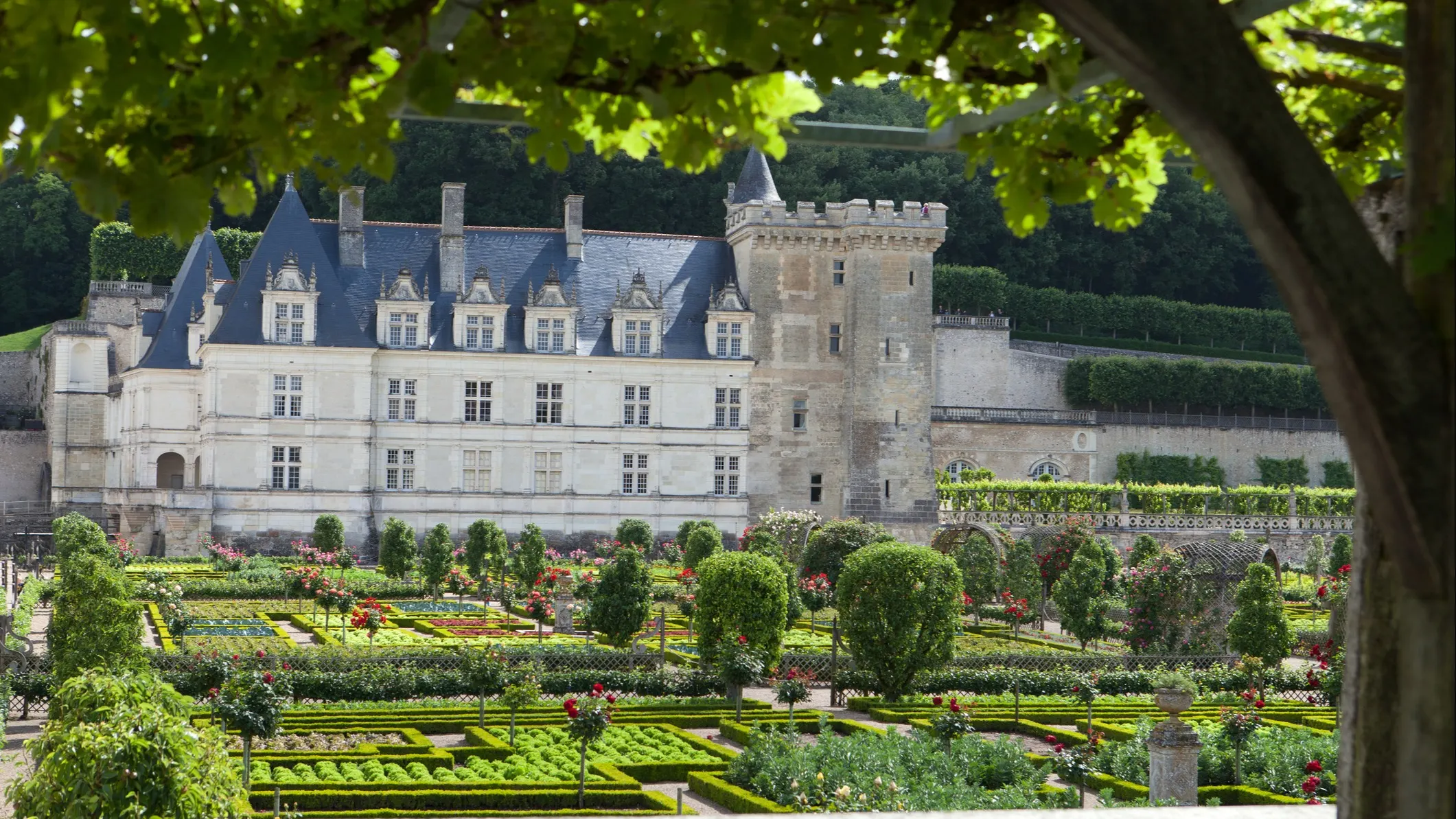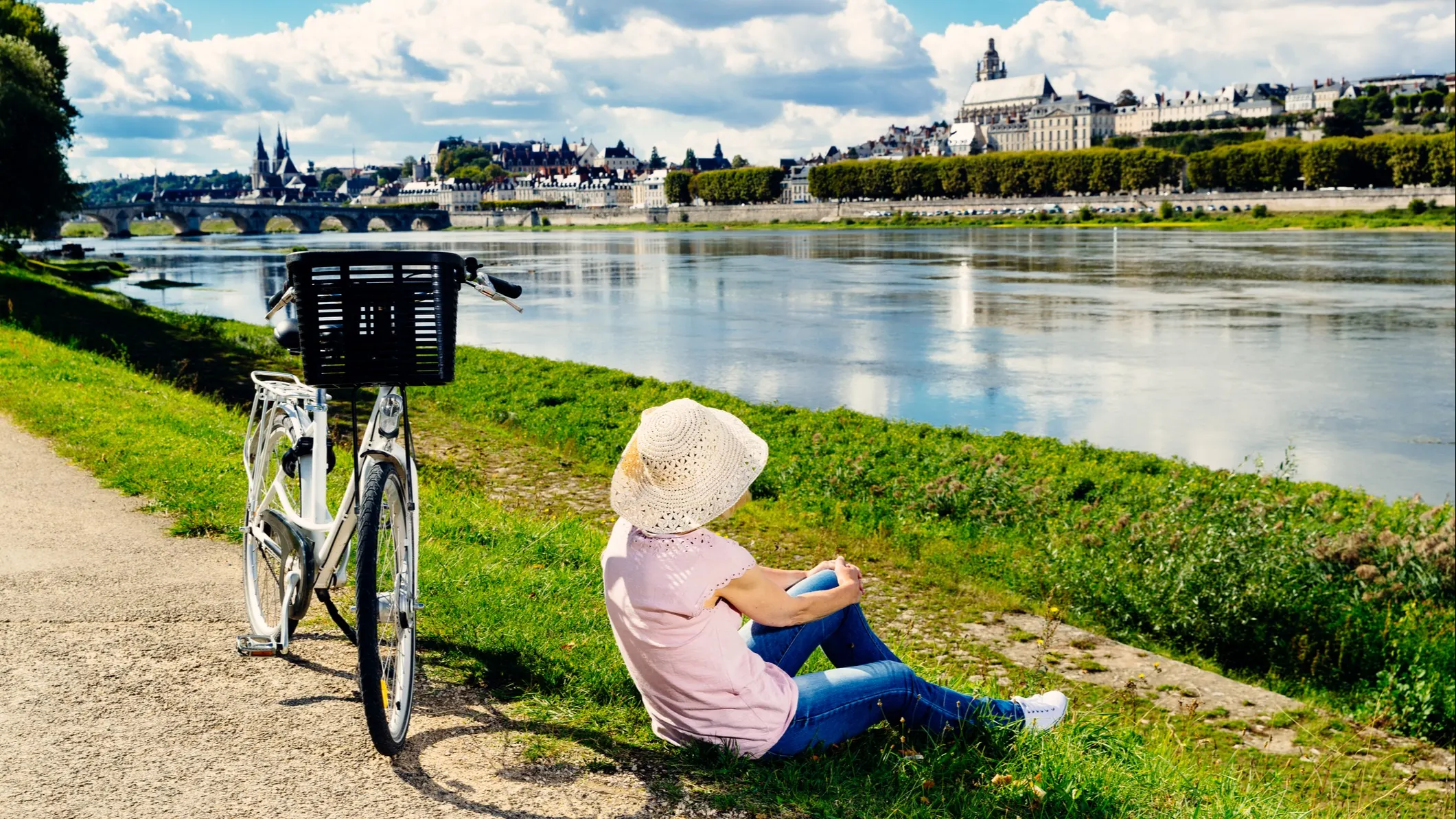The Castles of France’s Loire Valley
11 min readIt was almost sunset, and the countryside of the Loire Valley was tinged with a warm, golden glow. Our hot-air balloon’s basket nearly brushed the treetops below us, so the pilot squeezed a lever to inject more fuel into the flame. Almost instantly, the black-and-yellow balloon soared higher, and we continued our thrilling flight over rows of vines, rolling hills, and centuries-old châteaux (castles).
Once we had landed, our fellow passengers went off on their way. As luck would have it, my then-fiancé, Shawn, and I were invited to an outdoor picnic being held for the hot-air balloon pilots and their guests. There was much wine, food, and fun conversation to be had over dinner. Once our dining partners heard it was Shawn’s birthday, word spread quickly. Soon, the entire tent of revelers broke into a lively rendition of “Happy Birthday, ˮ in English— and en Français.
Learn more about France and other countries in our daily postcard e-letter. Simply enter your email address below and we’ll send you a FREE REPORT: A Taste of France: All the Ingredients for the Good Life.
By submitting your email address, you will receive a free subscription to IL Postcards and special offers from International Living and our affiliates. You can unsubscribe at any time, and we encourage you to read more about our Privacy Policy.

©iStock/PJPhoto69
We’d traveled to this legendary swathe of France to celebrate Shawn’s birthday, but I felt like I was getting a gift, too. The Loire Valley was an area I’d dreamed of visiting since high school, when my French teacher introduced my class to a handful of the more than 300 châteaux that dot the Loire landscape.
The Loire Valley’s first major fortifications were built during medieval times to repel the Vikings. However, the grand châteaux that you might already be familiar with mostly date to France’s Renaissance period. During this time, King François I, who reigned from 1515 to 1547, continued building monumental royal abodes in the Loire Valley. François also invited Italian Renaissance geniuses, such as Leonardo da Vinci, to be a part of his inner circle, amplifying the cultural and philosophical exchange that took place during this period.
Beyond its world-famous Renaissance châteaux, the Loire Valley is also a celebrated agricultural area. Dubbed the “Garden of France,” the fertile region is blanketed with about 165,000 acres of vineyards, which produce an incredibly diverse range of wine. The valley’s abundant orchards, fields, and forests also yield an impressive range of fruit and vegetables—even gourmet ingredients like black truffles, saffron, and white asparagus.
The Loire Valley also has a bounty of historic cities and towns to explore. Some of the most historic are Angers, Orléans (of Joan of Arc fame), Saumur (home to a mushroom museum and a world-famous equestrian riding school), and Tours.
When Shawn and I were planning our trip, we kept hearing about “château fatigue.”
This is the sense of overwhelm visitors might feel if they add too many castles to their Loire itineraries. To avoid this phenomenon, we carefully selected a variety of châteaux to visit, including the four below.
Learn more about France and other countries in our daily postcard e-letter. Simply enter your email address below and we’ll send you a FREE REPORT: A Taste of France: All the Ingredients for the Good Life.
By submitting your email address, you will receive a free subscription to IL Postcards and special offers from International Living and our affiliates. You can unsubscribe at any time, and we encourage you to read more about our Privacy Policy.
Chambord is a château of superlatives: It’s the Loire’s most visited and its grandest. Chambord’s grounds are also considered to be Europe’s largest enclosed park—incredibly, the park is about the same size as Paris proper.
In 1519, France’s king, François I, initiated Chambord’s construction, with the intent of building a luxurious hunting lodge. For nearly three decades, laborers and craftsmen toiled away to build Chambord. Despite these impressive efforts and mammoth expenditures, the French monarch is said to have been finicky—ultimately preferring his other castles over Chambord.
Colossal Chambord has 426 rooms, 282 fireplaces, and 83 staircases. An exceptional staircase—shaped like a double helix—is one of Chambord’s star attractions. It’s said to be ingenious because people climbing and descending the stairs at the same time will never cross paths.
What’s more, there’s even a chance that Leonardo da Vinci influenced the design of Chambord’s signature staircase. The Italian polymath lived in the Loire Valley for the last years of his life and was greatly admired by François I, who was a patron of the arts.
Whether or not Leonardo was the designer of the staircase, there is one certain Leonardo connection: During World War II, his most famous painting, the Mona Lisa, was moved out of the Louvre and safeguarded inside Chambord for a while.
As you wander through Chambord’s rich interior, be on the lookout for François I’s emblem, which features a salamander and a crown. You’ll have ample opportunities to find it since the amphibian appears about 300 times on the château’s ornate ceilings and walls.
Once you’ve climbed to Chambord’s upper levels, be sure to savor the details of the chimneys, domes, and turrets that, clustered together, dominate Chambord’s fairy-tale exterior. While you’re up there, also step outside onto the terraces and enjoy the splendid views of Chambord’s grounds below. This sprawling green space is home to an impressive range of creatures, including deer, wild boar, and about 150 bird species. You can explore the outdoor space by bike, on foot, or by horse-drawn carriage.
Tickets to Chambord cost €14.50 ($16.40). If you’re intrigued by the prospect of exploring hidden spots that are closed to the general public, guided tours are also available. Throughout the year, Chambord hosts special events, including musical performances, festive Christmas celebrations, and summertime equestrian and bird-of-prey shows.
Learn more about France and other countries in our daily postcard e-letter. Simply enter your email address below and we’ll send you a FREE REPORT: A Taste of France: All the Ingredients for the Good Life.
By submitting your email address, you will receive a free subscription to IL Postcards and special offers from International Living and our affiliates. You can unsubscribe at any time, and we encourage you to read more about our Privacy Policy.
Built in 1471 and located in Amboise, the Château du Clos Lucé is most often associated with Leonardo da Vinci, who lived there for three years.
In 1516, François I invited Leonardo to be part of his court, proclaiming him the “premier painter, engineer, and architect of the king.” At age 64, Leonardo made the treacherous journey across the Alps from Italy to Amboise Leonardo is said to have ridden on a mule with some of his most precious cargo in tow, including the Mona Lisa, and many of his notes and drawings.
In exchange for Leonardo’s service, François I gave him a pension and allowed him to reside inside Clos Lucé, a pinkish-brick manor home. Clos Lucé is about half a mile from the Château d’Amboise, where many of France’s kings, including François I, lived.
This proximity, coupled with an underground tunnel connecting the two châteaux, allowed these two prominent characters to regularly meet to discuss collaborations. During his time at Clos Lucé, multi-talented Leonardo planned elaborate galas and completed engineering projects for François I. In 1519, Leonardo died at Clos Lucé. His purported remains are now buried inside a tomb on the grounds of the Château d’Amboise.
In recent years, Clos Lucé’s interior has been restored to reflect what it would’ve looked like when Leonardo lived there. You can see his former bedroom, workshop, and more.
Outside the château is the Parc Leonardo da Vinci, an open-air museum that contains life-size examples of Leonardo’s inventions, including an armored tank, portable bridge, catapult, and an early helicopter.
The park was my favorite part of the tour, thanks to its hands-on nature. Elsewhere on the grounds is a state-of-the-art cultural space in which Leonardo’s most famous works are projected. Tickets to Clos Lucé are €18 ($20.35).

©iStock/wjarek
Originally, Villandry was a medieval fortress. However, during the 16th century, François I’s finance minister and ambassador to Italy, Jean Le Breton, acquired Villandry and oversaw the structure’s great transformation to become a Renaissance château. Jean had developed an interest in Italian Renaissance gardens during his diplomatic pursuits in Italy, and this undoubtedly influenced the development of Villandry’s magnificent gardens.
Today, Villandry has a splendid variety of gardens, including a Water Garden, Ornamental Garden (whose sections depict different types of love), Maze, and Sun Garden.
In recent years, Villandry’s gardens have become more sustainable. Not only are they organic, but the gardeners also send green waste to a composting center. What’s more, Villandry is accredited by the French Society for the Protection of Birds.
The Château de Villandry is located about 11 miles from Tours. Tickets to the castle and gardens cost €12 ($13.55), whereas garden-only tickets are €7.50 ($8.47). Note that the gardens are generally in bloom from April to October.
Learn more about France and other countries in our daily postcard e-letter. Simply enter your email address below and we’ll send you a FREE REPORT: A Taste of France: All the Ingredients for the Good Life.
By submitting your email address, you will receive a free subscription to IL Postcards and special offers from International Living and our affiliates. You can unsubscribe at any time, and we encourage you to read more about our Privacy Policy.
Located on an island between two branches of the Indre River, Azay-le-Rideau epitomizes fairy tale romanticism. Though Azay-le-Rideau is more petite than other castles in the Loire Valley, its graceful turrets, charcoal-grey rooftop, and elegantly carved windows unite with its waterside setting to create an irresistible attraction.
Azay-le-Rideau was made from a type of local white limestone called tuffeau. This stone’s soft qualities made it easier to sculpt the decorative elements of the château’s exterior.
Built by Gilles Berthelot and his wife, Philippe Lesbahy, in the early 16th century, the château and village of the same name have a multilayered history. Originally, there was a Roman villa here, and later, a medieval castle was built. The latter structure was eventually burned to the ground during the Hundred Years War. Nothing but ruins remained for about one century, until Gilles and Philippe acquired the land. Gilles was an influential figure who served as treasurer to François I.
Eventually, Gilles and Philippe were ousted from the château due to royal drama, and over the next few centuries, Azay-le-Rideau had numerous owners. During the Franco-Prussian War, the château even housed Prussian leaders. In 1905, the French government acquired Azay-le-Rideau.
The château’s interior is furnished in the Italian Renaissance style and features foreign accessories, such as ornate Flemish tapestries that depict scenes from the Bible and Greek mythology.
Outside, some of Azay-le-Rideau’s grounds are dressed in English-style gardens, but much of the property is forested with non-native tree species like Sequoias, Cedars, and Ginkgo Biloba. The château’s natural areas are a refuge for an array of wildlife, including bats and dragonflies.
Azay-le-Rideau is located about 16 miles southwest of the city of Tours. Admission is €11.50 ($13).

©iStock/lucentius
Roughly 175 miles from end to end, the Loire Valley is located on the middle section of the Loire, France’s longest river. In 2000, the central part of the valley (which stretches from the city of Chalonnes-sur-Loire in the west, to Sully-sur-Loire in the east) was inscribed on UNESCO’s World Heritage List. Depending on how far west you venture, this UNESCO-listed area is about 1.5 to 2 hours from Paris.
Getting There: The city of Tours is located about halfway between Chalonnes-sur-Loire and Sully-sur-Loire. Because of its central location, Tours is a popular gateway for exploring the Loire’s attractions. Tours is well-connected by roadways and train. It’s on a high-speed TGV line, so you can reach Paris in about 1.5 hours and Bordeaux in 2.5 hours. In addition, the Tours Val de Loire Airport (TUF) is a few miles from Tours.
Getting Around: Public transport options, including trains, can be limited the farther you get from urban areas. As a result, having your own car can be essential for reaching the Loire’s more remote sights. If you’d rather not drive yourself, many companies offer minivan tours. Their itineraries include visits to a variety of châteaux, and sometimes even wineries. Many operators, including France Intense and A la Française, allow you to customize your tour.
Where to Stay: From quaint gîtes (B&Bs) to châteaux offering a stay fit for a royal, the Loire Valley offers a great variety of accommodation options. For something luxurious, consider the Le Relais de Chambord. Located on the grounds of the Château de Chambord, Le Relais de Chambord is a four-star boutique hotel that boasts a fine restaurant, spa, and views of the château. There are several suites but the most unusual is housed on a traditional Loire riverboat that’s moored on the canal alongside the château. If you’d prefer a city hub instead, the reasonably priced Hôtel Val de Loire is located in Tours, inside a 19th-century mansion. The property has 14 rooms, which are furnished with antique furniture and modern touches. The Hôtel Val de Loire overlooks a tree-lined boulevard and is a 15-minute walk from the half-timbered buildings of Tours’ Old Town.
What to Drink: The Loire Valley is France’s third-largest wine region and one of the country’s most diverse. More than 20 varieties of grapes are grown in the Loire, including reds like Cabernet Franc, and whites such as Chenin Blanc and Melon de Bourgogne. Several châteaux even produce their own wine, including Brissac (known for its rosé) and Brézé (which even offers a sparkling Crémant). For a comprehensive directory of wineries, see Loire Valley Wines.
Hot-Air Balloon Rides: Want to see the sites from the air as we did? When we arrived in Tours, we asked the city’s tourist office about hot-air balloon rides (Montgolfières) in the Loire Valley. The office booked our flight with Aérocom. The Tours Tourist Office website also maintains this list of hot-air balloon operators. Note that many companies only offer flights between April and October.
Learn more about France and other countries in our daily postcard e-letter. Simply enter your email address below and we’ll send you a FREE REPORT: A Taste of France: All the Ingredients for the Good Life.
By submitting your email address, you will receive a free subscription to IL Postcards and special offers from International Living and our affiliates. You can unsubscribe at any time, and we encourage you to read more about our Privacy Policy.
Related Articles
Moving to France Will Be the Best Move You’ve Ever Made
5 Best Cities and Towns to Live and Retire in France
5 Places to Live in France; 2 to Avoid


